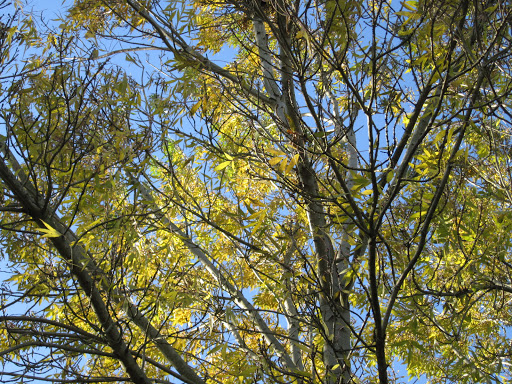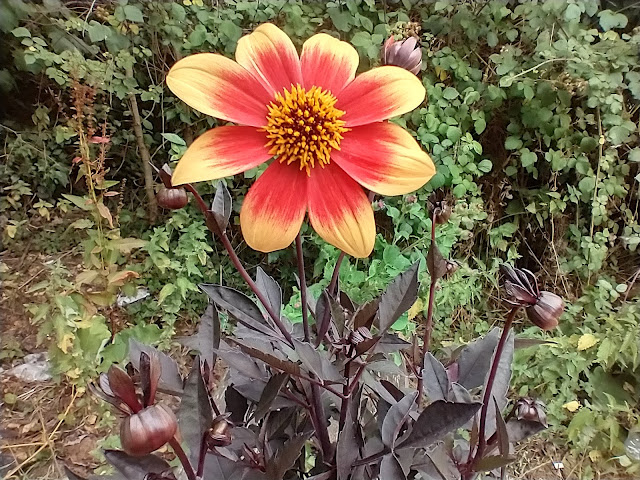Ashes to Ashes?
I spent a huge chunk of the weekend peering up at the ash trees (Fraxinus excelsior) at the side of our house. They're always one of the last trees to decide it's autumn and last week they finally donned their seasonal clothes of buttery yellow. Saturday's blue sky and slanting sunshine made for perfect viewing. It's something I always do at this time of year, but this time was a poignant one because of the recent news about ash dieback fungus (aka Chalara fraxinea).
This fungus has attacked ash trees across Europe the past few years, for example decimating around 90% of those found in Denmark. Cases have been reported recently in East Anglia and Kent and many concerned groups - especially The Woodland Trust - have been actively lobbying the government to act swiftly to prevent the disease from spreading.
Today, a ban on the import of ash trees comes into force and a number of civil servants have been redeployed to cope with the extra work anticipated over the coming months. Only time will tell if the government has acted quickly enough. Around 5% of our trees are ash and whilst that might not sound a lot, in some places their presence accounts for much more.
One of those places is the area next to our house. We have three ash trees next to our garden fence, two at the back and one at the front. In addition ash trees line the banks of Hardenhuish Brook close by. Along with the leaf miner ridden horse chestnuts I've written about previously, ash trees shape our immediate and local landscape.
Whilst they're not actually in the garden, the trees do much to give it its sense of place. The sound of the wind rustling through the leaves helps to drown nearby traffic noise and their shading of half the garden informs my plant choices. We often watch the daily soap opera of the local wildlife taking place within their branches, which on one memorable occasion was a sparrowhawk sitting within a few feet of the house. The trees also shape some of my regular gardening tasks: there's plenty of leaves to be collected from the back lawn at the moment and I'm forever pulling up ash seedlings during the summer months.
Whilst their lofty presence is both a blessing and a curse, I know I'd miss them if they became infected and had to go. It's a notifiable disease, so I'll be keeping an eye on the trees and any of their twigs and branches which drop into the garden in future.
The Forestry Commission's website provides lots of information about the disease, its known whereabouts in the UK and provides links to various agencies should you need to report an outbreak. It also links to Forest Research's very good pdf format pictorial identification guide and video. It's a website worth keeping an eye on, if like me ash trees form part of your local landscape too.
I also made a couple of short videos on Saturday to try and capture some of the huge presence these trees have for us. The one below shows the way the shadows of the leaves in the breeze affects the light in our kitchen at this time of the year.
If the video won't play from the picture, try this link instead. The second video attempts to capture the sound of the trees whilst out in the garden.
Update: There's an android App launched today to help identify and track the disease across the UK. Take a look at the Ash Tag website. Update 30/10: App also available on Apple..











Yon kit does not appear impressed with the lovely patterns on the wall ;) My camera battery is fully charged, so I shall attempt to capture the sounds of the trees & winds a little later, when our bit of Sandy blows through. Thinking of those trees being felled causes pain.
ReplyDeletePetoskystone - no, he was more concerned with polishing off his breakfast. Hope you and yours keep safe whilst hurricane Sandy rages.
ReplyDeleteI am surprised the government didn't act sooner given that the problem has been apparent in Europe for years. Let's hope it is not too late to save the trees but I am not optimistic - it is rare for some pest, plant or disease not to spread once it has gained a toehold.
ReplyDeleteEG - me too. I would have thought that Sudden Oak Death etc would have concentrated their minds a bit, but sadly not.
ReplyDeleteWill be peering along intently with you VP, as we have an large inherited ash in the back garden. We live in a hollow and it provides a great privacy screen, sheltering us from the neighbours above. I would not even begrudge the pesky squirrels one of their favourite playgrounds,should it continue to flourish. I have a sinking feeling about the fate of our ashes but let's hope for the best.
ReplyDeleteIt's bizarre, how slow the response to this has been. Caroline Lucas in parliament today, berating both Conservatives and Labour for being so slow off the mark.
ReplyDeleteAnna - our ash trees are a great privacy screen too. We have a public footpath at the side of the house, so don't want to lose their shelter from that. I'm hoping the doom and gloom of the past few weeks doesn't become the reality like we had for our elm trees in the 70s.
ReplyDeleteLucy - I'm very surprised too. After Leaf miner moth/bleeding canker in horse chestnuts and the culls owing to sudden oak death, you'd think we'd have been much more prepared for this, especially as it's been a known disease marching ever closer for a number of years now.
Now my ash trees leaf out last and lose leaves first...and how sad your ash trees are in trouble too as ours are being decimated by an Asian beetle the Emerald Ash Borer.
ReplyDeleteHi Donna - there seems to be a whole raft of new and exotic pests & diseases threatening our trees at the moment :(
ReplyDelete